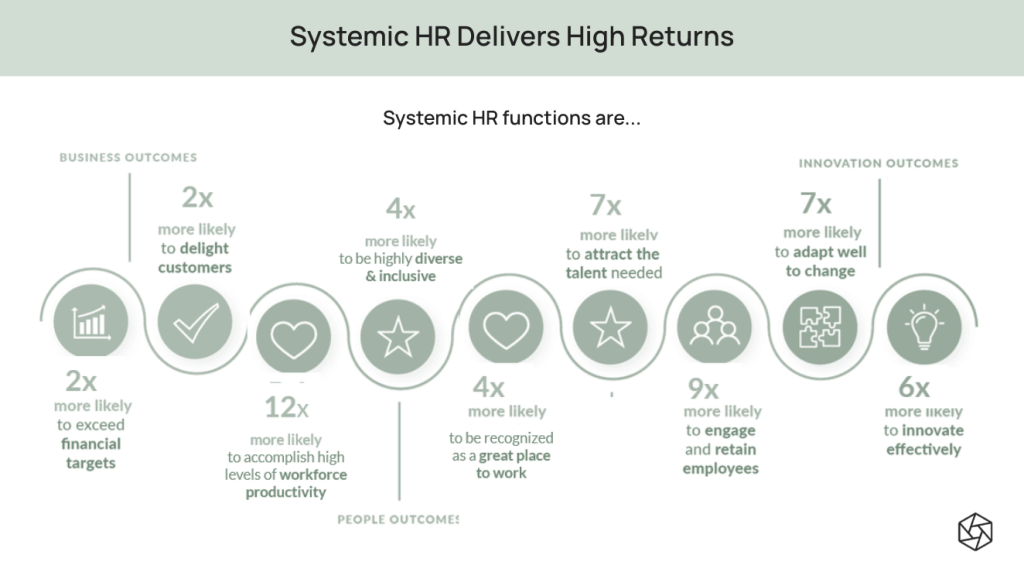The HR industry is facing an unprecedented shift. With the advancement of AI and the rapid development of technology, the focus has shifted away from the traditional individual training approach towards a more systemic problem-solving approach. As the skills gap continues to grow, employers must find ways to bridge the divide between technology and job functions.
In this article we explore how organizations can move from individual training to holistic problem-solving, allowing for a deeper understanding of how skills gaps can be addressed in the workplace.
Why the shift from Jobs to Skill-based jobs is necessary
In today’s ever-changing business landscape, the shift from traditional job-focused roles to skill-based jobs is becoming increasingly necessary. This shift is driven by the rapid advancement of technology, the rise of artificial intelligence (AI), and the need for organizations to remain competitive and adaptable in the face of constant market changes.
Talent evolution is a key factor in this transition. As new technologies emerge and industries evolve, the skills required for success are also changing. A report by the World Economic Forum indicates that around half of all employees will require significant reskilling and upskilling by 2025. In order to stay ahead, organizations must prioritize continuous learning and development (L&D) to ensure their workforce has the necessary skills to thrive in the future of work.
A skill-based approach allows organizations to be more agile in adapting to changing market demands. Instead of relying solely on specific job titles or roles, employees are encouraged to develop a wide range of transferable skills that can be applied across various tasks and projects. This not only increases the overall flexibility and versatility of the workforce but also promotes a culture of innovation and collaboration.
Understanding Systemic HR and its benefits
Systemic HR is a new approach that takes into account the broader context and interdependencies within an organization. It recognizes that individual training programs are no longer sufficient to address the complex challenges of today’s workforce. Instead, systemic HR focuses on holistic problem-solving, taking into consideration the overall ecosystem of the organization.
The key benefits of systemic HR
#1 It’s ability to drive reskilling and upskilling initiatives.
Traditional training programs often focus on individual employees and their immediate needs. However, systemic HR takes a broader view, identifying skills gaps and addressing them at a systemic level. This approach not only ensures that the workforce has the skills necessary to thrive in the future, but it also promotes a culture of continuous learning and development.
#2 It’s ability to design and implement effective learning programs
By taking into account the unique context and business strategy of an organization, systemic HR can create targeted and relevant learning experiences. These programs go beyond simply teaching specific skills; they provide employees with the knowledge and tools they need to contribute to the overall success of the organization.

SOURCE: Josh Bersin, Why It’s Time For A New Era In Human Resources. Enter Systemic HR.
From reactive to proactive – moving away from individual training
The traditional method of individual training, where employees are only provided with the specific skills they need for their current job, is no longer sufficient to meet the challenges of the future. Instead, a proactive approach that focuses on holistic problem-solving is necessary to drive organizational success.
This means looking beyond the immediate needs of individual employees and considering the broader context within the organization. However, many organizations struggle to identify the existing skills within their teams. Capturing and sustaining skills across the organization is just the beginning.
Those who get it right have a lot to gain. Tech adopters that succeed at reskilling to accommodate technology-driven job changes report a revenue growth rate of 15% on average according to IBM IBV research. And the value added is even greater for those that emphasize AI: they see a 36% higher rate of revenue growth than their peers.
Context, Strategy, and Skills: The Triad for Success
To successfully transition from individual training to holistic problem solving, organizations must understand the importance of context, business strategy, and skills. These three ingredients are the key to unlocking the full potential of the systemic approach to HR:
Context
Context plays a vital role in determining the specific skills that are needed within an organization. Each company has its own unique set of challenges, goals, and market conditions. By understanding the context in which they operate, organizations can identify the skills that are most valuable and relevant to their success.
Business strategy
The skills required for success may vary depending on the organization’s strategic goals. For example, if a company is focused on expanding into new markets, it may need employees with skills in market research, business development, and cultural competency. The average half-life of skills is now less than five years (meaning that every five years, that skill is about half as valuable as it was before), and in some tech fields it’s as low as two and a half years.
Skills
Skills are the building blocks of a successful organization. By identifying the skills that are most critical to the organization’s success and implementing initiatives to develop those skills, HR professionals can ensure that employees are prepared for the challenges of the future. This includes both technical skills, such as coding or data analysis, and soft skills, such as communication and leadership.
Best practices for implementing a systemic approach to HR
Implementing a systemic approach to HR requires careful planning and execution. Here are some best practices to help organizations effectively transition from individual training to holistic problem-solving.
- Conduct a skills gap analysis: This involves assessing the current skills of your workforce and comparing them to the skills needed for future success. By understanding where the gaps are, you can develop targeted learning and development initiatives to bridge them. This kind of analysis helps you decide whether to “buy or build” these skills. In 2020, a study of three companies found that “building technical skills” can be as much as six times less expensive than buying (hiring).
- Align with organizational goals: Ensure that your L&D initiatives are aligned with your organization’s strategic objectives. By focusing on the skills that are most critical to achieving these goals, you can drive better organizational performance and success.
- Foster a culture of continuous learning: Encourage a mindset of lifelong learning within your organization. This can be done by promoting the value of learning, providing opportunities for growth and development, and recognizing and rewarding employees who actively seek to improve their skills.
- Embrace technology: Leverage technology tools, such as Hive Learning, to support your systemic approach to HR. Hive Learning can provide personalized and targeted learning experiences, facilitate collaboration and knowledge sharing, and provide valuable insights and analytics to measure the impact of your initiatives.
- Evaluate and adjust: Regularly evaluate the effectiveness of your learning and development initiatives and make adjustments as needed. This could involve collecting feedback from employees, tracking learner engagement and progress, and analyzing the outcomes of your initiatives.
Conclusion
By embracing these best practices, organizations can effectively transition from individual training to holistic problem-solving. The systemic HR approach, with its focus on context, business strategy, and skills, not only bridges the gap between technology and job functions but also fosters a culture of continuous learning and development.
In an era where adaptability and innovation are paramount, this approach can bridge the gap between technology and job functions, drive better organizational performance, and thrive in the future of work. Hive Learning is here to empower that change. Our AI-powered platform and unique approach ensures that learning experiences are aligned with your business-specific content and strategy.
Contact us today to find out how you can redefine your HR journey and embrace the new era of tailored skills development.

